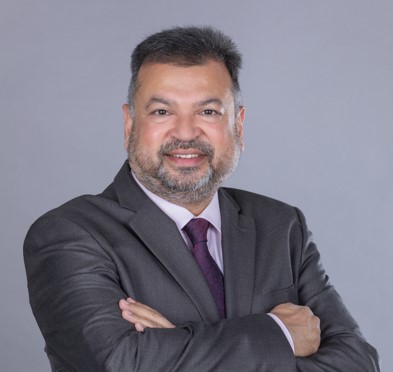Scroll, Shrug, Forget: The World’s Numbness to the War on Healthcare

Sunoor Verma, Director Partnerships and Outreach, WISH-QF
Imagine this: a hospital is levelled, doctors massacred, ambulances blown apart, medical students kidnapped. The story sprints across your newsfeed, just another pebble in the landslide of daily horror. By lunchtime, the outrage has already faded, replaced by lighter fare, cat videos, and the latest on a sun-drenched celebrity spat. We know the Geneva Conventions. We remember the hallowed symbol of the Red Cross and Red Crescent, borne aloft amid battlefields and disaster zones for more than a century. Yet here in 2025, global shock at attacks on health feels as rare as a full moon over London in August. Clinics and caregivers are bombed and burnt out, not by accident, but by design. How did this most sacred taboo in modern war become just another passing headline, barely grazing the public conscience?
Peter Sandman, crisis communication’s relentless gadfly, would have a field day. Sandman’s mantra, risk equals hazard plus outrage, remains unbroken long past the days when epidemiologists and emergency planners first scrawled it on flipcharts. When people are truly furious, they don’t just see high risk; they act as if their hair’s ablaze. Yet, when it comes to attacks on hospitals, the world wears a wet towel on its head and scrolls on. Why aren’t we collectively incandescent? Why does this horror trickle away, leaving only the faintest ripple of frustration or malaise? The answer lies not in the scale of violence, which is deeper than ever, but in how outrage is conjured, managed and, most damningly, muffled.
Let’s get one thing straight: what’s happening in Gaza, Ukraine, Sudan, Myanmar, and elsewhere isn’t mere collateral damage. These are not random acts by rogue squads but deliberate, systematic campaigns. The World Health Organisation counted over 1,300 attacks on health facilities in 2023; the Ministry of Health in Gaza records entire hospital systems systematically dismantled, nearly 500 staff dead or missing by spring 2024. In Ukraine, ambulances become moving targets, volunteer drivers painting over red crosses in a grim bid to survive the road. In Sudan, paramedics are executed, sometimes live-streamed for good measure. Myanmar’s clinics are closed, torched, commandeered at the first sign of fighting. These attacks are neither accidental nor isolated; they form part of a broader strategy, a war on healthcare and, by extension, on humanity.
But strategy is not the only part of this moral car crash. The real tragedy is how blithe we have become. A single image of a maternity ward bombed in Sarajevo once shook talk shows from Sydney to Stockholm; now, Syria’s chemical attacks on clinics or Gaza’s flattened paediatric wards generate hashtags, not movements. What has happened to our outrage? Sandman would point to the wiring of human emotion: outrage, that indispensable fuel for action, doesn’t arise from facts alone. It bubbles up when risks feel unfair, involuntary, close to home, and imposed by untrustworthy villains. But none of these dials is being sufficiently turned.
Take distance. Outrage, like risotto, needs proximity. A hospital airstrike in Khartoum or Kiev is a million emotional miles from readers in Paris or Jakarta. The vast majority don’t know a Sudanese paediatrician or Palestinian nurse; to them, these are voiceless, faceless others. Geography and culture turn tragedy into a kind of white noise: dreadful but not urgent. Human beings burn bright for those they count as kin or neighbours; all else is statistics. Even as 2024 outstrips all prior years for dead and wounded health workers, connections haven’t kept pace. No connection, no outrage.
Next, voluntariness. Outrage rises when others are seen as victims without a say. Yet the populations of Syria, Myanmar, and Gaza are so chronic, so ever-persecuted, their victimhood almost feels voluntary, a fate bored into our collective psyche. Health workers are praised for “noble self-sacrifice”, but quietly, the implication is they signed up for danger. The world forgets: no Red Crescent doctor trains for execution, no nutrition nurse registers expecting artillery.
Then, trust. Outrage erupts when trusted sources, governments, NGOs, and health agencies validate that something is rotten and point a trembling finger at the culprits. Instead, modern crisis communication greets us with a polished fugue of the obvious: “We must protect the sanctity of healthcare”; “The parties to the conflict should respect international humanitarian law.” Should, must, ought, the conjugations of abdication, passing the baton of blame—no names named, no emotion leaking through. Empathy is quarantined, passion airbrushed from every press release by teams more concerned with diplomatic bruises than wounds in flesh and bone. Where’s the righteous fury? Where’s the trembling voice saying, “I failed”? Health leaders sidestep, as if outrage were radioactive, best handled with twelve-foot tongs. By the time their bland apologia meets the public, it induces sleep, not action.
Which brings us to fairness. Attacks on health are the definition of unfair, but nothing seems more normalised. With every report, “1,342 clinics destroyed in 2023, another paramedic beheaded in Darfur today”, the world grows numb. Why? Because the messaging is relentless and impersonal. It’s numbers shorn of stories, wrongs stated in spreadsheet form. Even atrocity breeds familiarity, and as Sandman reminds us, repetition flattens offence. The more often the humanitarian red line is crossed without consequence, the more it blurs into battlefield dust.
But here’s a pointed question, rarely voiced: if warring sides today are willing to target women, children, or the elderly, the most defenceless, how realistic is it to expect restraint when it comes to health or education? If the taboo against attacking civilians has already crumbled, what remains to shield ambulance crews or classroom teachers? The moral ground beneath humanitarian law has eroded so severely that appeals to conscience or norms ring hollow. We presume the existence of boundaries, imploring armies to spare hospitals and schools, yet in truth, the boundaries were trampled long ago. Hoping for a selective respect of sanctuaries from actors already mired in atrocities becomes less a principle than a wish.
This is not simply a story of leaders ducking responsibility. The media, too, are trapped. Once, a war crime might lead the hour; now, a bombing in Kherson or Gaza must compete against Wimbledon, a political scandal, or a celebrity divorce. Social media makes matters worse. Algorithms serve us what we want, or what we already believe. Siloed in echo chambers, news about Sudan’s murdered medics or Gaza’s obliterated ambulance convoys drowns in distraction. If a crisis doesn’t fit between TikTok dances or football highlights, it perishes. Communal attention spans atomised into oblivion.
The result? Outrage diffuses. Tragedy becomes wallpaper. Each new outrage, the bombing of maternity wards, the murder of paramedics, the decimation of ICU units, lands more softly as our shock threshold rises. The more often the humanitarian red line blurs, the more it seems a relic of a vanished age.
Sandman, ever the provocateur, would say the failure lies not in our hearts but in leadership’s management of outrage. Crisis communication isn’t merely passing information; it’s stirring moral engagement. When leaders fail to show vulnerability, to name and shame, they undermine the engine of public anger and action. The “we should…the world must…the parties ought to…” genre of crisis talk soothes accountability, but dooms itself to irrelevance. People respond to leaders who weep, who rage, who admit feebleness but still stand defiant. No one ever marched for a passive voice, nor shed a tear for a press release.
Can we reignite outrage? The answer lies in changing the message, messenger, and method. The most potent currency now is storytelling, raw, personal, unfiltered. Foreground the lives and deaths of real doctors, real families. Show a Sudanese driver’s last WhatsApp, a Syrian paediatrician’s trembling hands, a Gaza nurse’s despair. Make “health attack” a story, not just a data point. Bring audiences close, not as observers, but as witnesses.
Yet the solution does not end there. Leadership in health and humanitarian agencies must rediscover risk, for progress demands it. “Don’t name a country or an armed group; you’ll lose access or put a partner in peril.” But risk-aversion breeds apathy. Without boldness, even limited moral expectations vanish in the smoke of artillery. We need leaders who lean in when the boundaries of permissible dissent are tested, who admit fear but refuse silence.
And there is a structural deficit. Multilaterals, mainly the UN and its kin, have floated off so high in the diplomatic stratosphere that their impact is atmospheric, a drizzle of “concern”, nothing that wets the ground. Regional alliances hold more promise; they have skin in the game, know the levers and politics. If outrage can be seeded locally, it can take root regionally and stick. Regional bodies are imperfect but impatient: a hospital bombed today can bring refugees tomorrow, political fallout at home. Campaigners and health leaders need to knock on these doors and forge alliances with local heroes.
And never underestimate the public. Outrage, once sparked, moves swiftly. When George Floyd’s last breath circled the globe, outrage became action, cities, continents apart. The lesson: address root crises in individual drama, speak plainly, and demand accountability. “We, the undersigned, demand that the bombing of ambulances end. Here is what you can do. Here is who is responsible.”
Nothing guarantees that outrage will bloom in a world this weary, but the retreat into polite nihilism, “the world must…”, lets the war on health become as unremarkable as weather. Outrage lies dormant, waiting not for more tragedy, but for better leadership, braver storytelling, and narratives that land so close to home, we cannot help but care.
Next time a clinic falls, or a medic pays with her life, ask: Who will speak honestly, risk offence, name the guilty, and tell the story fiercely enough to ignite a thousand hearts? That is what Peter Sandman would demand. That is what the world and the wounded deserve. Only then will the cross or crescent atop a roof mean sanctuary again, and not just another target ignored.
#Crisis Communication #Leadership Communication #IHL #Outrage #GlobalHealthDiplomacy #Risk Communication #HealthEmergency



